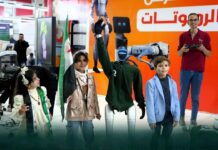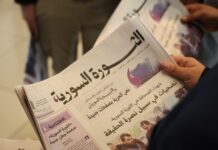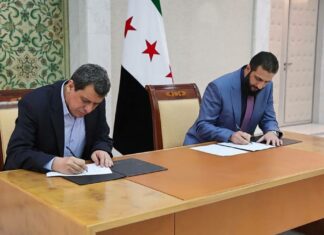
In a step that represents a qualitative shift in the path of Syrian media, the capital, Damascus, witnessed the relaunch of the Syrian Arab News Agency (SANA) in a new and advanced form, under the slogan “SANA… A Turning Point.” A grand ceremony was held at the National Center for Visual Arts, attended by government officials and media professionals.
A Shift from Ideology to Professionalism
In his speech, Minister of Information Hamza al-Mustafa emphasized this moment represents the beginning of a new page in the path of Syrian state media. He explicitly compared SANA’s past as a mere “transmitter of the text written by the authorities” to its new identity as a “comprehensive news agency” with a local and international network of correspondents. He pledged that this transformation will be reflected in its style, analysis, and the breadth of its content, and that media freedom would be protected within the framework of this official government model.
Technical and Professional Transformation
SANA Director General Ziad al-Mahamid announced a new philosophy for the agency, aiming to transform the work of SANA’s staff from mere recipients of instructions to field journalists who ensure the accuracy of information and convey it professionally.
The transformation includes a reformulation of the editorial policy and the training of a new generation of journalists in partnership with local and international institutions, instilling values of credibility and professionalism. New tools were also developed, modern filming equipment was integrated, and five languages were added in addition to Arabic (English, French, Turkish, Spanish, and Kurdish). The agency added new visual content, professional photos, and high-quality videos.
In a statement to Levant 24, Mahamid emphasized the importance of adding the Kurdish language to SANA’s website and platforms, given the diversity of the Syrian people, rich in cultures and ethnicities. He explained that this step will enable coverage of news from this essential component of the Syrian society, especially in the eastern region.
Institutional Support and a Future Vision
Khalid al-Khalaf, director of the Al-Wahda Foundation for Press, Printing, and Publishing, revealed to Levant 24 that the relaunch is part of a broader plan approved by the president to reform national media, which includes the establishment of a new official television channel, a newspaper, and a radio station. Khalaf confirmed that the official newspaper, Al-Thawra, is being developed to align with these new standards.
He emphasized the utmost importance of ensuring that Syrian journalism reflects the country’s sectarian and ethnic diversity and meets the needs of all segments of society, including the Kurdish population. To prevent any loopholes that could be exploited by parties seeking to distort Syria’s image or incite discord. The new SANA is presented as the cornerstone of this unified, forward-looking national media strategy.
A Visual Heritage Telling Syria’s History
As part of the launch event, SANA presented an exhibition of historic cameras and photographs, symbolizing the evolution of Syrian photojournalism. Veteran photojournalist Muhammad Suleiman described how simple, old equipment gradually evolved into more advanced tools, enabling photographers to document Syria’s story with increasing creativity and professionalism. The exhibition was divided into a technical section featuring old cameras and a photography section showcasing prominent works reflecting decades of Syrian visual history.
Cultural and Intellectual Support
Prominent intellectuals and artists expressed their support for the new initiative. Poet Anas al-Daghim expressed his hope that the revitalized SANA would faithfully convey the truth and honor the sacrifices of all Syrians. Artist Dr. Sarah Rose presented artwork reflecting SANA’s historical role and the importance of preserving Syrian cultural heritage in the age of new media.








